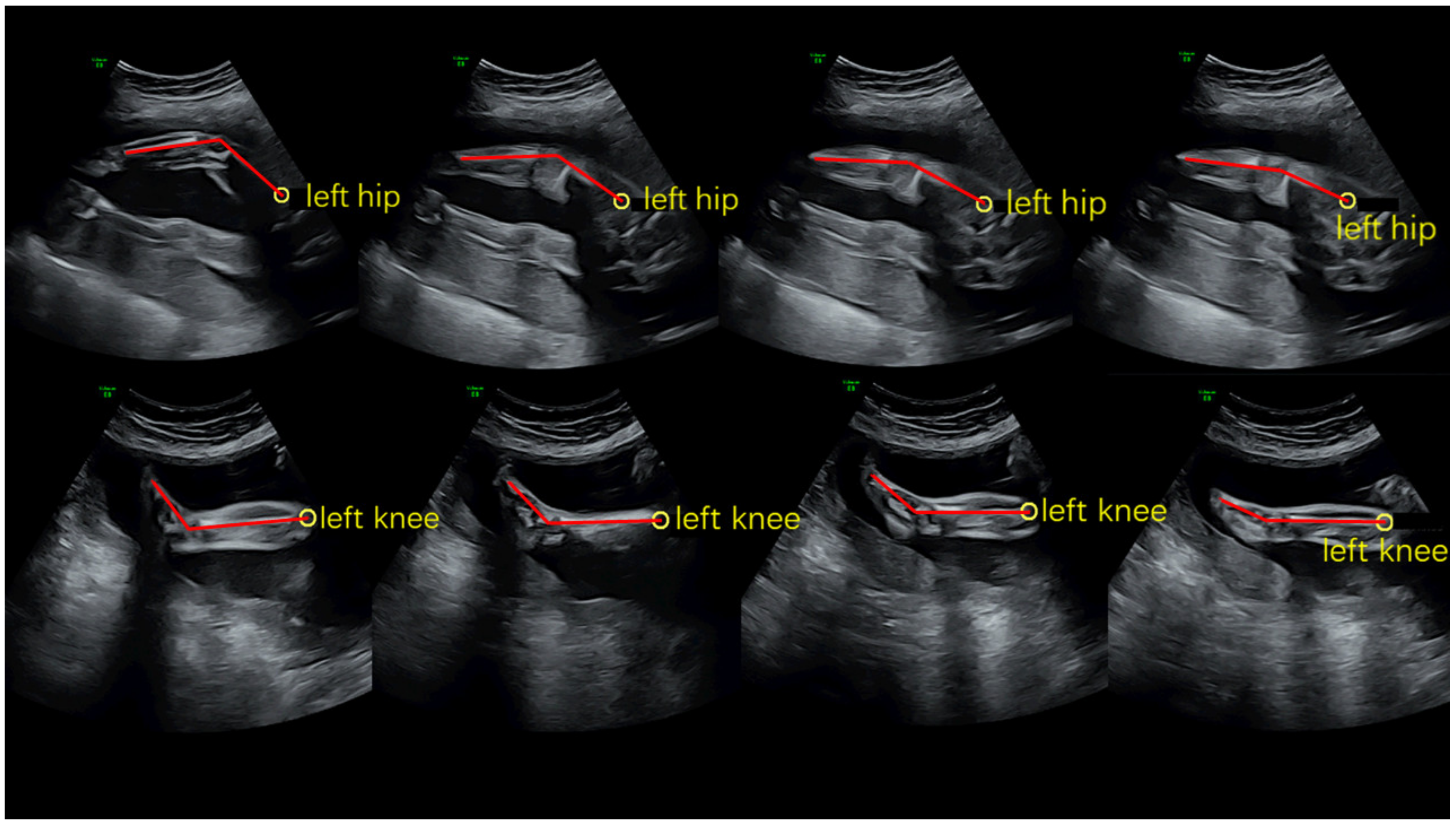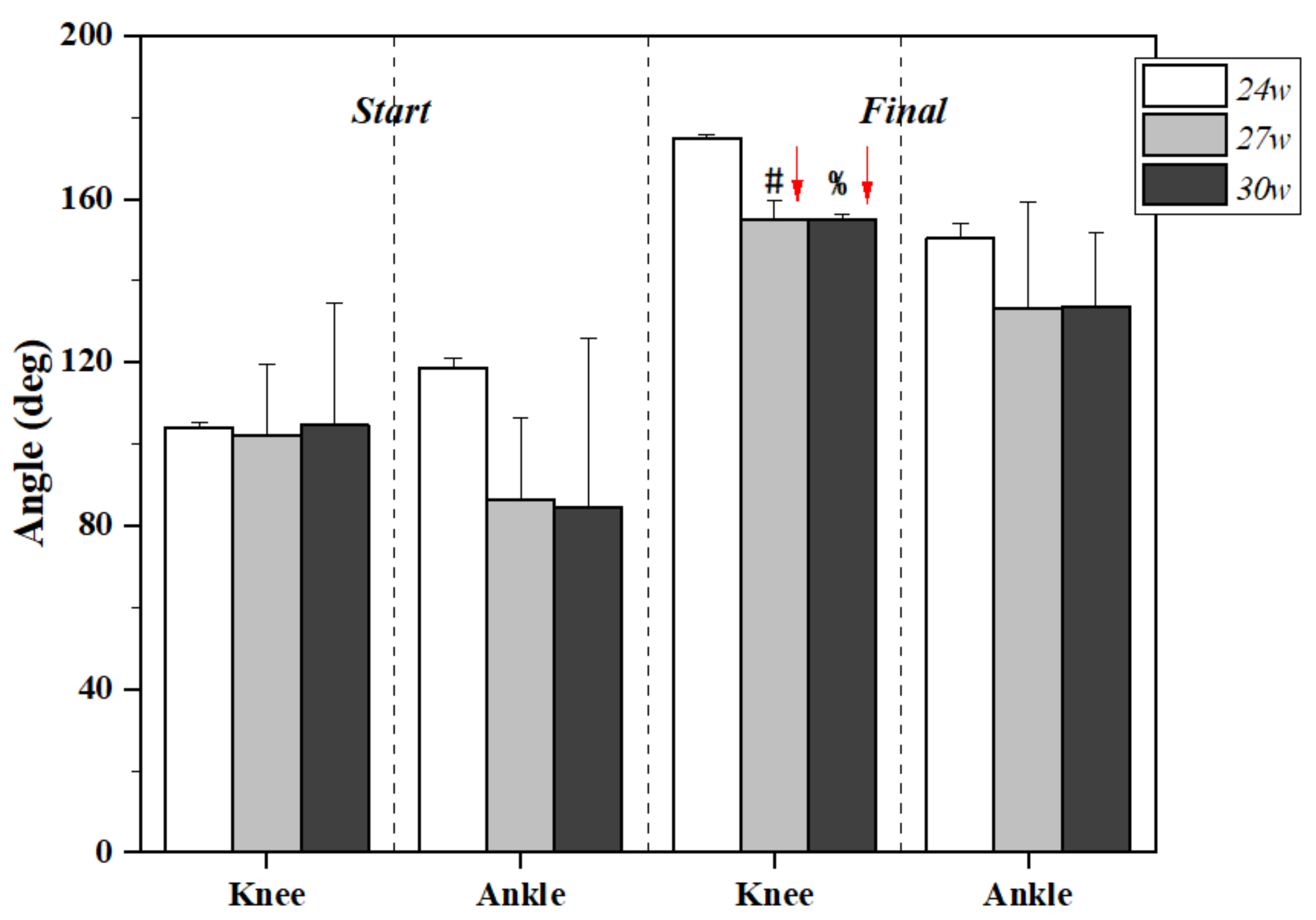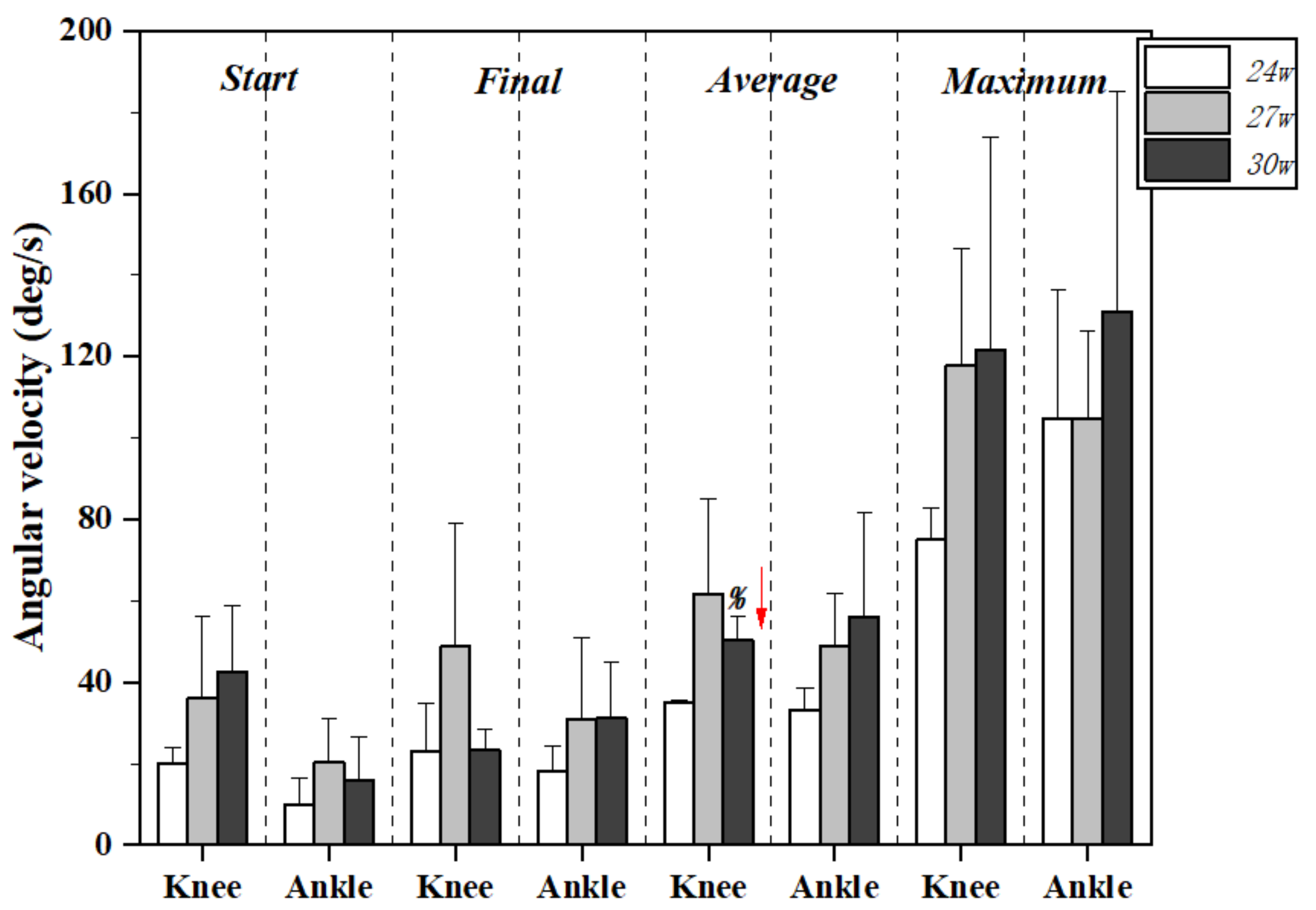Kinematic Comparison on Lower Limb Kicking Action of Fetuses in Different Gestational Weeks: A Pilot Study
Abstract
:1. Introduction
2. Materials and Methods
2.1. Participants
2.2. Ultrasound Scanning Processing
2.3. Kinematics Analysis Processing
2.3.1. The Angle of the Knee and Ankle Joints of the Lower Extremities
2.3.2. The Angle Velocity of the Knee and Ankle Joints of the Lower Extremities
2.4. Statistical Analysis
3. Results
3.1. Lower Limb Joint Angle Changes
3.2. Lower Limb Joint Angular Velocity Changes
4. Discussion
5. Conclusions
Author Contributions
Funding
Institutional Review Board Statement
Informed Consent Statement
Data Availability Statement
Conflicts of Interest
References
- Verbruggen, S.W.; Kainz, B.; Shelmerdine, S.C.; Arthurs, O.J.; Hajnal, J.V.; Rutherford, M.A.; Phillips, A.T.; Nowlan, N.C. Altered biomechanical stimulation of the developing hip joint in presence of hip dysplasia risk factors. J. Biomech. 2018, 78, 1. [Google Scholar] [CrossRef] [PubMed]
- Cioni, G.; Ferrari, F.; Einspieler, C.; Paolicelli, P.B.; Barbani, T.; Prechtl, H.F. Comparison between observation of spontaneous movements and neurologic examination in preterm infants. J. Pediatr. 1997, 130, 704–711. [Google Scholar] [CrossRef]
- Jansson, L.M.; DiPietro, J.; Elko, A. Fetal response to maternal methadone administration. Am. J. Obstet. Gynecol. 2005, 193, 611–617. [Google Scholar] [CrossRef] [PubMed]
- Nowlan, N. Biomechanics of foetal movement. Eur. Cells Mater. J. 2015, 29, 1–21. [Google Scholar] [CrossRef] [PubMed]
- De Vries, J.I.; Visser, G.H.; Prechtl, H.F. The emergence of fetal behaviour. I. Qualitative aspects. Early Hum. Dev. 1982, 7, 301–322. [Google Scholar] [CrossRef]
- Yu, L.; Mei, Q.; Mohamad, N.I.; Gu, Y.; Fernandez, J. An exploratory investigation of patellofemoral joint loadings during directional lunges in badminton. Comput Biol Med. 2021, 132, 104302. [Google Scholar] [CrossRef] [PubMed]
- Verbruggen, S.W.; Loo, J.H.; Hayat, T.T.; Hajnal, J.V.; Rutherford, M.A.; Phillips, A.T.; Nowlan, N.C. Modeling the biomechanics of fetal movements. Biomech. Model. Mechanobiol. 2016, 15, 995–1004. [Google Scholar] [CrossRef] [PubMed] [Green Version]
- Sarode, V.; Chimurkar, P.M.; Cheeran, A.N. Electrical impedance tomography (EIT) based medical imaging using finite element method (FEM). Int. J. Eng. Sci. Emerg. Technol. 2012, 1, 83–89. [Google Scholar] [CrossRef]
- Aly, H.M.; El-Hadidy, E.I. Kinematic Description of Fetal Lower Limbs Movements in the Three Trimesters of Pregnancy. In Proceedings of The 17th International Scientific Conference Faculty of Physical Therapy Cairo, Cairo, Egypt, 10–11 March 2016; pp. 1–14. [Google Scholar]
- De Vries, J.; Fong, B. Normal fetal motility: An overview. Ultrasound Obstet. Gynecol. 2006, 27, 701–711. [Google Scholar] [CrossRef] [PubMed]
- Ten Hof, J.; Nijhuis, I.; Nijhuis, J.; Narayan, H.; Taylor, D.; Visser, G.; Mulder, E. Quantitative analysis of fetal general movements: Methodological considerations. Early Hum. Dev. 1999, 56, 57–73. [Google Scholar] [CrossRef]
- Winiarski, S. Human locomotion analysis technique with SIMI Motion. Acta Bioeng. Biomech. 2003, 5, 544–550. [Google Scholar]
- Yi, G. Application of Simi Motion Capture System in Gait Recognition. Chin. J. Forensic Sci. 2013, 2, 66–70. [Google Scholar]
- Cerda-Lugo, A.; González, A.; Cardenas, A.; Piovesan, D. Modeling the neuro-mechanics of human balance when recovering from a fall: A continuous-time approach. Biomed. Eng. Online 2020, 19, 1–24. [Google Scholar] [CrossRef] [PubMed]
- Kahn, J.; Shwartz, Y.; Blitz, E.; Krief, S.; Sharir, A.; Breitel, D.A.; Rattenbach, R.; Relaix, F.; Maire, P.; Rountree, R.B. Muscle contraction is necessary to maintain joint progenitor cell fate. Dev. Cell 2009, 16, 734–743. [Google Scholar] [CrossRef] [PubMed] [Green Version]
- Xuan, R.; Yu, P. Medical image application in fetal weight prediction between ultrasound and magnetic resonance imaging: A systematic review. J. Med. Imaging Health 2020, 10, 1144–1148. [Google Scholar] [CrossRef]
- Ren, S.; Gao, Y.; Yang, Z.; Li, J.; Xuan, R.; Liu, J.; Chen, X.; Thirupathi, A. The effect of pelvic floor muscle training on pelvic floor dysfunction in pregnant and postpartum women. Phys. Act. Health 2020, 4, 130–141. [Google Scholar] [CrossRef]
- Hayat, T.; Nihat, A.; Martinez-Biarge, M.; McGuinness, A.; Allsop, J.; Hajnal, J.; Rutherford, M. Optimization and initial experience of a multisection balanced steady-state free precession cine sequence for the assessment of fetal behavior in utero. Am. J. Neuroradiol. 2011, 32, 331–338. [Google Scholar] [CrossRef] [PubMed] [Green Version]
- Riegger-Krugh, C.; Blair, A.; Sparling, J.W. Assessment of fetal knee angular velocity as a possible method to determine the effect of prenatal exposure to cocaine. Phys. Occup. Ther. Pediatr. 1996, 16, 173–186. [Google Scholar] [CrossRef]
- Gao, Y.; Ren, S.; Zhou, H.; Xuan, R. Impact of physical activity during pregnancy on gestational hypertension. Phys. Act. Health 2020, 4, 32–39. [Google Scholar] [CrossRef] [Green Version]



| Gestational Weeks | p Values, Mean Difference (95%CI) | |||||
|---|---|---|---|---|---|---|
| 24 Weeks | 27 Weeks | 30 Weeks | 24 w/27 w | 24 w/30 w | 27 w/30 w | |
| Mean ± SD | Mean ± SD | Mean ± SD | ||||
| Knee | ||||||
| Start angle | 104.15 ± 1.20 | 102.28 ± 17.35 | 104.73 ± 29.69 | 0.97, 1.87 (−31.14, 34.89) | 0.99, −0.58 (−59.72, 58.55) | 0.98, −2.45 (−56.65, 51.75) |
| Final angle | 174.76 ± 1.04 | 154.99 ± 4.49 | 154.89 ± 1.55 | <0.01, 19.75 (9.47, 30.03) | <0.01, 19.86 (12.04, 27.68) | 0.99, 0.11 (−9.81, 10.03) |
| Ankle | ||||||
| Start angle | 118.60 ± 2.44 | 86.36 ± 19.90 | 84.50 ± 41.32 | 0.09, 31.69 (−9.40, 72.80) | 0.36, 33.56 (−52.52, 119.64) | 0.99, 1.86 (−77.11, 80.84) |
| Final angle | 150.34 ± 3.60 | 133.15 ± 26.13 | 133.46 ± 18.46 | 0.48, 17.19 (−36.60, 70.99) | 0.30, 16.88 (−20.65, 54.41) | 1.00, −0.31 (−51.01, 50.38) |
| Gestational Weeks | p-Values, Mean Difference (95%CI) | |||||
|---|---|---|---|---|---|---|
| 24 Weeks | 27 Weeks | 30 Weeks | 24 w/27 w | 24 w/30 w | 27 w/30 w | |
| Mean ± SD | Mean ± SD | Mean ± SD | ||||
| Knee | ||||||
| Start angular velocity | 19.95 ± 3.84 | 36.11 ± 20.01 | 42.70 ± 15.99 | 0.27, −16.15 (−50.41, 18.10) | 0.08, −22.74 (−50.94, 5.45) | 0.82, −6.58 (−40.46, 27.29) |
| Final angular velocity | 22.83 ± 11.86 | 48.75 ± 30.14 | 23.37 ± 5.01 | 0.26, −25.92 (−75.86, 24.00) | 0.99, −0.54 (−19.08, 17.99) | 0.26, 25.38 (−26.33, 77.09) |
| Average angular velocity | 35.04 ± 0.48 | 61.49 ± 23.44 | 50.22 ± 5.83 | 0.23, −26.45 (−78.16, 25.24) | 0.02, −15.18 (−26.58, −3.78) | 0.68, 11.27 (−38.75, 61.30) |
| Maximum angular velocity | 75.13 ± 7.67 | 117.98 ± 28.44 | 121.42 ± 52.32 | 0.28, −42.84 (−135.85, 50.15) | 0.29, −46.28 (−149.43, 56.86) | 0.99, −3.43 (−107.08, 100.21) |
| Ankle | ||||||
| Start angular velocity | 9.86 ± 6.62 | 20.44 ± 10.55 | 15.98 ± 10.69 | 0.29, −10.58 (−30.78, 9.62) | 0.62, −6.11 (−26.56, 14.32) | 0.82, 4.46 (−18.57, 27.50) |
| Final angular velocity | 18.02 ± 6.44 | 30.82 ± 20.20 | 31.22 ± 13.86 | 0.51, −12.79 (−52.57, 26.98) | 0.29, −13.19 (−39.72, 13.34) | 0.99, −0.39 (−39.43. 38.63) |
| Average angular velocity | 33.23 ± 5.36 | 49.01 ± 13.00 | 55.94 ± 25.58 | 0.17, −15.77 (−40.85, 9.30) | 0.31, −22.70 (−74.53, 29.12) | 0.88, −6.93 (−55.72, 41.86) |
| Maximum angular velocity | 104.77 ± 31.49 | 104.57 ± 21.61 | 131.04 ± 54.14 | 1.00, 0.19 (−60.64, 61.03) | 0.69, −26.27 (−129.52, 76.98) | 0.66, −26.46 (−131.17, 78.24) |
Publisher’s Note: MDPI stays neutral with regard to jurisdictional claims in published maps and institutional affiliations. |
© 2021 by the authors. Licensee MDPI, Basel, Switzerland. This article is an open access article distributed under the terms and conditions of the Creative Commons Attribution (CC BY) license (https://creativecommons.org/licenses/by/4.0/).
Share and Cite
Chen, H.; Song, Y.; Xuan, R.; Hu, Q.; Baker, J.S.; Gu, Y. Kinematic Comparison on Lower Limb Kicking Action of Fetuses in Different Gestational Weeks: A Pilot Study. Healthcare 2021, 9, 1057. https://doi.org/10.3390/healthcare9081057
Chen H, Song Y, Xuan R, Hu Q, Baker JS, Gu Y. Kinematic Comparison on Lower Limb Kicking Action of Fetuses in Different Gestational Weeks: A Pilot Study. Healthcare. 2021; 9(8):1057. https://doi.org/10.3390/healthcare9081057
Chicago/Turabian StyleChen, Hairong, Yang Song, Rongrong Xuan, Qiuli Hu, Julien S. Baker, and Yaodong Gu. 2021. "Kinematic Comparison on Lower Limb Kicking Action of Fetuses in Different Gestational Weeks: A Pilot Study" Healthcare 9, no. 8: 1057. https://doi.org/10.3390/healthcare9081057
APA StyleChen, H., Song, Y., Xuan, R., Hu, Q., Baker, J. S., & Gu, Y. (2021). Kinematic Comparison on Lower Limb Kicking Action of Fetuses in Different Gestational Weeks: A Pilot Study. Healthcare, 9(8), 1057. https://doi.org/10.3390/healthcare9081057









